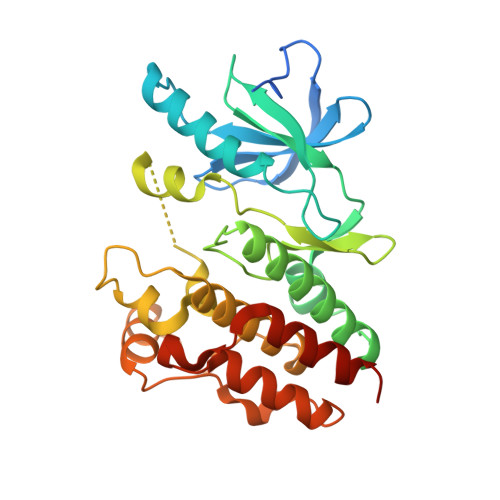Purinylpyridinylamino-based DFG-in/ alpha C-helix-out B-Raf inhibitors: Applying mutant versus wild-type B-Raf selectivity indices for compound profiling.
Liu, L., Lee, M.R., Kim, J.L., Whittington, D.A., Bregman, H., Hua, Z., Lewis, R.T., Martin, M.W., Nishimura, N., Potashman, M., Yang, K., Yi, S., Vaida, K.R., Epstein, L.F., Babij, C., Fernando, M., Carnahan, J., Norman, M.H.(2016) Bioorg Med Chem 24: 2215-2234
- PubMed: 27085672
- DOI: https://doi.org/10.1016/j.bmc.2016.03.055
- Primary Citation of Related Structures:
5FD2 - PubMed Abstract:
One of the challenges for targeting B-Raf(V600E) with small molecule inhibitors had been achieving adequate selectivity over the wild-type protein B-Raf(WT), as inhibition of the latter has been associated with hyperplasia in normal tissues. Recent studies suggest that B-Raf inhibitors inducing the 'DFG-in/αC-helix-out' conformation (Type IIB) likely will exhibit improved selectivity for B-Raf(V600E). To explore this hypothesis, we transformed Type IIA inhibitor (1) into a series of Type IIB inhibitors (sulfonamides and sulfamides 4-6) and examined the SAR. Three selectivity indices were introduced to facilitate the analyses: the B-Raf(V600E)/B-Raf(WT) biochemical ((b)S), cellular ((c)S) selectivity, and the phospho-ERK activation ((p)A). Our data indicates that α-branched sulfonamides and sulfamides show higher selectivities than the linear derivatives. We rationalized this finding based on analysis of structural information from the literature and provided evidence for a monomeric B-Raf-inhibitor complex previously hypothesized to be responsible for the desired B-Raf(V600E) selectivity.
- Department of Medicinal Chemistry, Amgen Inc., One Amgen Center Drive, Thousand Oaks, CA 91320, USA. Electronic address: lliu@amgen.com.
Organizational Affiliation:

















